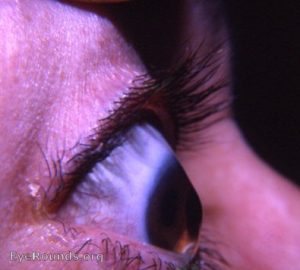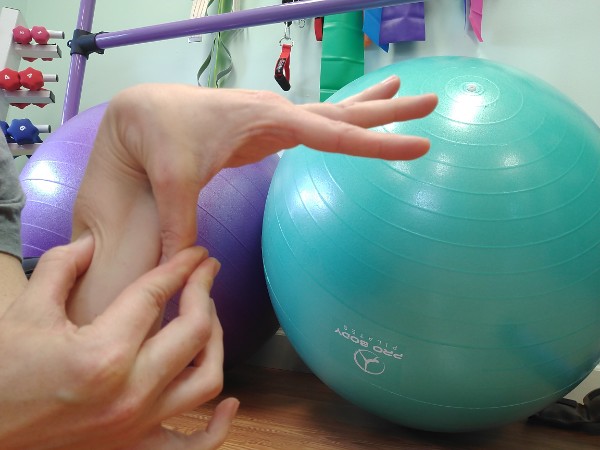Ehlers Danlos Syndrome (EDS) is what is known as a connective tissue disorder. Connective tissue provides support and holds the body’s tissues together. It is made up of a small fraction of cells in a larger extracellular matrix. The extracellular matrix is composed of collagen, elastin and reticular fibers.1 One of the fundamental mechanisms known to produce EDS is deficiency of collagen-processing enzymes. This results in the structure and strength of the collagen fibrils being compromised.2 Collagen makes up 80% of structures in the eye. At least six types of EDS have been identified and genetic testing has been developed for all but hypermobility-type EDS. The type that most severely affects the collagen of the eye is the very rare Kyphoscoliosis Type (formerly type VI).3 Due to the specific enzyme affected by this type of EDS causing weakness in the formation of collagen of the eye, the eye can be perforated with very little trauma.4 This type of EDS is very rare, with fewer than 60 known cases worldwide.5 However, other types of EDS can also affect the eye and vision due to the similar types of collagen-weakening mechanisms.

Common ophthalmologic considerations for EDS include myopia (near-sightedness), glaucoma and retinal detachment. Another common ocular complication of EDS is keratoconus-a condition in which the cornea bulges outward and then gravity pulls it downward causing blurred vision that isn’t fully corrected even with glasses or contact lenses. This can be treated with rigid contact lenses and various surgical options. Blue sclera may occur in patients with EDS, this is a blue appearance of the whites of the eyes caused by thinness of the sclera. Angioid streaks, generally harmless in themselves, indicate connective tissue disorder as they are breaks in one of the connective tissue layers of the eye and should be monitored for abnormal growth of blood vessels in these cracks. Redundant or drooping skin of the eyelid may be present due to eyelid laxity.4 Dry eyes are also very common in patients with EDS affecting 63% of patients. This may be due to impaired closure of the eyelids resulting in overexposure of the eyes to the environment.6 This dryness can then contribute to another common EDS-related ocular issue- light sensitivity, known as photophobia. Strabismus or abnormal alignment of the eyes either toward a cross-eyed alignment or to the opposite away from midline alignment is another common and not well understood EDS-related issue. This too can be surgically corrected, but surgery is not a good choice for first-line treatment for patients with EDS due to the complications it causes with healing.7
People with EDS should see an optometrist or ophthalmologist for a comprehensive baseline and exam and then annually for follow-up. It is important to have a relationship with a professional who can determine if any issues that come up are EDS-related and treat them accordingly. Problems that would require intensive evaluation in a patient with EDS include blurred vision or double vision that comes and goes, complete/almost complete vision loss in one eye, migraine auras, dry eyes, light sensitivity, tunnel vision, and floaters. Emergency assistance should be sought if a person with EDS experiences double vision that starts suddenly, flashes of light, pain, redness or discharge, curtain coming up over vision, frontal headache in which patient “hears pulse in the temple,” or sudden change in vision.3 These issues can indicate vascular damage and increased risk of life-threatening arterial rupture in patients with vascular types of EDS.
I help many patients with EDS by giving them tools to manage and treat their musculoskeletal complaints. I am not an expert in vision therapy or eye care. This blog article is meant to be purely informational. If this subject interests you I recommend you check out the references below. As stated above, please consult with an eye care professional for more information about how these issues may affect you.
- https://sciencing.com/7-types-connective-tissue-8768445.html
- Mao, Jau-Ren and James Bristow. The Ehlers-Danlos syndrome: on beyond collagens. J Clin Invest. 2001 May 1; 107(9): 1063–1069.
- Opthalmology Medical Resource Guide. Ehlers-Danlos National Foundation.
- https://totaleyecare.com/ocular-complications-ehlers-danlos-syndrome/
- https://www.chronicpainpartners.com/types-of-eds/
- https://www.theraspecs.com/blog/ehlers-danlos-syndrome-light-sensitivity/
- James Kundart OD, MEd, FAAO, FCOVD-A. Ehlers Danlos Syndrome and the Eye.
 I can bend my thumb down so far that it touches my forearm. This is one of the stranger and more visible signs of hypermobility spectrum disorder (HSD) and Hypermobility Ehlers-Danlos Syndrome (EDS-HT). Other signs are hyperextension at the elbows and knees, being able to place your hands flat on the floor when bending forward at the waist while keeping your knees straight, and being able to bend your little finger back past 90 degrees. These are the signs used to diagnose hypermobility, which is simply a laxity or looseness in a person’s ligaments and connective tissue.
I can bend my thumb down so far that it touches my forearm. This is one of the stranger and more visible signs of hypermobility spectrum disorder (HSD) and Hypermobility Ehlers-Danlos Syndrome (EDS-HT). Other signs are hyperextension at the elbows and knees, being able to place your hands flat on the floor when bending forward at the waist while keeping your knees straight, and being able to bend your little finger back past 90 degrees. These are the signs used to diagnose hypermobility, which is simply a laxity or looseness in a person’s ligaments and connective tissue.